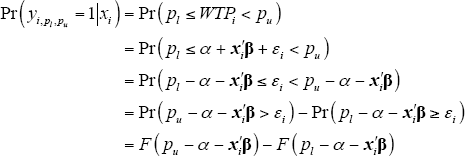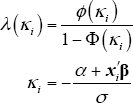RDP 2015-03: The Value of Payment Instruments: Estimating Willingness to Pay and Consumer Surplus Appendix B: Methodology – Estimation of Willingness to Pay
March 2015 – ISSN 1448-5109 (Online)
- Download the Paper 1.24MB
The methodology used to estimate willingness to pay follows the model developed by Hanemann et al (1991) for double-bounded DCE data.
For all N number of consumers, the ith consumer's willingness to pay (our variable of interest) to use a card instead of cash is specified as a continuous latent random variable represented by:
Here α is the mean willingness to pay (when all independent variables are zero), xi is the vector of independent variables, β is the vector of coefficients and εi is the normally distributed random error term with σ2 variance.
To obtain the estimates for the above parameters, the latent variable is mapped to the discrete data we observe, which is denoted by yi, pl, pu and takes the values:
where yi, pl , pu is the indicator flag taking the value 1 if consumer i's willingness to pay lies between the lower bound price pl and upper bound price pu, or taking the value zero otherwise. pl is an element of the set L of lower bound prices (in basis points) of {−∞,10,50,75,100,200,300,400}. A corresponding pu, which is an element of the set U of upper bound prices {10,50,75,100,200,300,400,∞}, exists for each pl. The eight ranges of willingness to pay in basis points are:
The probability of respondent i having a willingness to pay within the range bound by pl and pu is given by:
where F() is the (non-standard) normal cumulative distribution function of εi.
The log-likelihood function for the full sample is given by:
where pl ∈L, pu ∈U refers to the eight pairs of price points referred to above (as opposed to every combination of the price bounds).
The log-likelihood function is maximised using a Newton-Raphson numerical optimisation procedure in Stata.
B.1 Calculation of the truncated mean
The mean of the normal distribution above the truncation point is as derived in Greene (2012):
where  ,
following the specification above. The inverse Mills ratio λ(κ)
for a distribution that is truncated at zero for values below zero is:
,
following the specification above. The inverse Mills ratio λ(κ)
for a distribution that is truncated at zero for values below zero is:
where ϕ is the standard normal density function and Φ is the standard normal cumulative distribution function.
The mean of the distribution above the truncation point is then multiplied by the proportion of the distribution above the truncation point to arrive at the mean of the whole distribution.






